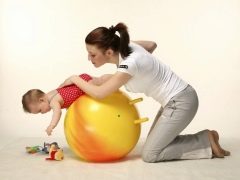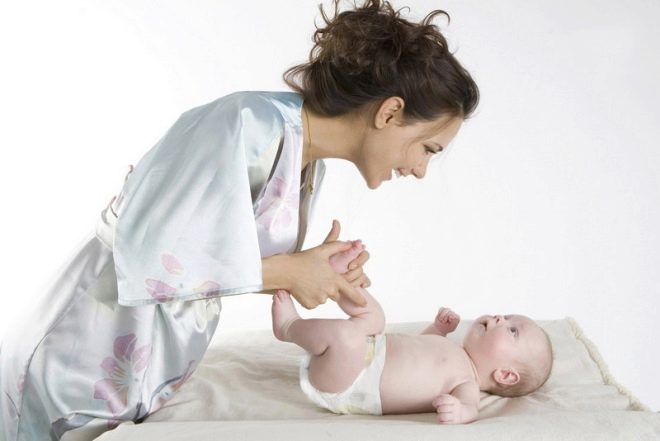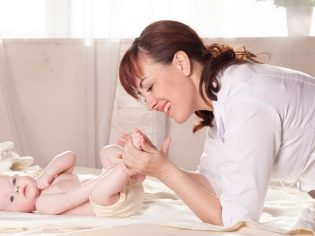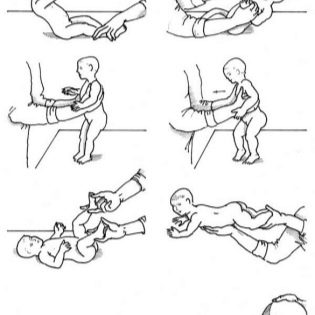Exercise therapy for children under one year
Gymnastics is useful to everyone, especially to children at an early age (up to a year) - fortifying gymnastics is often prescribed for all infants without exception. But there is another category of exercises - physiotherapy, which is prescribed in the case when the child has certain health problems.
Characteristics of the complex
Exercise therapy is a complex of physical exercises, which are designed to help in the complex treatment to cope with a certain pathology. Also gymnastics exercises are recommended for the prevention of disease recurrence.
The first developments in the field of exercise therapy belong to the healers of ancient China - it was they who founded the system, telling the world that certain muscles and loads on bones and joints work to a great extent for treating a patient. At the same time, they already had an idea of what movements are useful for a certain disease and what can do harm. This knowledge was supplemented and multiplied. Today, physical therapy is an autonomous branch of medicine. The most effective is the use of a specific set of exercises simultaneously with a therapeutic massage.
For children under one year, exercises from the exercise therapy system can also be used for prevention. They help to improve blood circulation, develop the muscular system and strengthen the musculoskeletal system, as well as improve the vestibular apparatus, improving coordination of movements.
Gymnastics improves the state of the nervous system, beneficially affecting the cerebral cortex. It helps to establish close emotional contact between mother and baby, and classes held for infants in the form of a game, contribute to the development of the child, stimulate speech skills.
How to learn?
You can learn the exercises from the complex physical therapy, visiting the office exercise therapy. He is in any children's clinic. A specialist will help you to make an exact set of exercises, given the exact age and diagnosis of the child. Therapeutic gymnastics, as well as therapeutic massage, has a lot of nuances, the observance and knowledge of which will increase the effect of training, and their ignorance can harm the child.
When mastering the exercises, the mother can use the existing schemes and illustrations of the technique for performing one or another technique. Sometimes a complex of exercises is prescribed by a doctor recommending gymnastics, for example, a pediatrician, a neurologist or an orthopedist.
Do not hesitate to ask questions - in this moment you need to clarify everything that can cause doubts and difficulties. It should be remembered that the complex exercise therapy for infants requires from adults accuracy and accuracy.
Kinds
Each pathology will have its own complex. But the main rule in drawing up the list of exercises for a child up to one year states that, first of all, the complex should correct the existing problem and only then serve as a means of preventing diseases and an instrument to strengthen the immune system.
When crooked. It is necessary to start gymnastics with crooked after a thorough massage of the shoulder girdle, the neck area, and the cervical region. Muscles and ligaments should be heated and ready for physical exertion. A short list of exercises is as follows:
- turning the head to the right and left, to the sick side - to the point of limitation;
- nods head up and down, bringing the baby's chin to the chest;
- raising the handles in the supine position and the abdomen above head level;
- spreading arms to the side, the movement of the shoulders back and forth.
It is recommended to perform each exercise 5 to 15 times, depending on the age of the baby and the severity of the pathology, all movements should be done by the mother with her own hands, but care must be taken not to injure the vertebrae.
With chest deformity
When a sunken or curved chest, the child needs loads on the muscles of the abdomen, hands, back, neck. Classes on the gym ball are very useful - in this case, the child is laid out with support on the ball and swing on the stomach and on the back.
With regard to therapeutic gymnastics, we can recommend the following exercises:
- extension and flexion of the arms not only at the elbow, but also at the shoulder joint, raising the arms vertically above the head;
- laying out on the tummy, crawling stimulation;
- stimulating coups from back to belly, to the right and left side;
- children older than 8 months - tilts (for a toy, a ball);
- dynamic exercises "Airplane", "Pendulum".
It is useful to stimulate the child's grasping skills - when the crumb reaches for a toy set in the distance, develop not only arm muscles, but also oblique pectoral muscles, neck and back muscles.
With hip dysplasia
Gymnastics performed after the massage. Each exercise must be agreed with the doctor. If the child wears orthopedic leg-length constructions, they should not move during the session. The complex aims to develop mobility and amplitude of the hip joints, to strengthen them. The following exercises are considered most effective:
- bringing the legs to the stomach at the same time and in turn ("Bicycle"):
- Frog posture - with legs spread in the pelvis and knee bent at a right angle on the back;
- Frog posture - in the prone position;
- circular movements of the legs in the hip joints (if the mobility is severely limited, then do the exercise in an arc);
- the rise of the legs straight in the knee with a bend in the hip joint to the head (position on the back);
- squats (for children older than 8-9 months, able to stand);
- forward bends (for babies older than 7 months);
- rotation of the legs and shaking them with a bend in the knee joint;
- stimulation of crawling on the stomach.
With this pathology, specific exercises are assigned only according to the results of a study that will show the angle of deviation of the hip joint from the norm. In case of dislocation, the loads should be minimal, whereas in case of joint immaturity and pre-dislocation, it is possible to exercise more intensively.
With cerebral palsy
With cerebral palsy, exercise therapy provides exercises for all muscle groups: they start from the extremities and end with the muscles of the back and abdomen. Gymnastics carried out after the massage. Its task is to stimulate the development of the muscular and skeletal system, the prevention of muscle atrophy, as well as the removal of heavy tone in the flattened limbs.
Among the exercises there is an extensive group of exercises in flexion and extension of the extremities. The arms are bent at the elbow, shoulder, wrist, massage and gymnastics for the fingers are required, if the degree of paralysis allows the child to move the fingers at least partially. The legs are flexed in the ankle, knee joint, diluted and reduced in the hip joint.
Weak abdominal muscles will become stronger if the parents include in the complex for the sick baby lining on the tummy and performing flexion and extension of the limbs in a position on the abdomen. Useful exercises on the ball.
When shunting the brain
Shunting is performed to children who have not been helped by conservative treatment of hydrocephalus. After surgery in the rehabilitation period, therapeutic gymnastics and massage are also recommended. When gymnastics should take into account that physical activity should be aimed at strengthening the muscles of the abdomen, back and limbs, as children who have undergone surgical treatment of hydrocephalus, are quite lagging behind in physical development.
Usually perform such a complex:
- the rise of the body and support on the arms (with the help of the mother) from a prone position;
- lifting and bending of all limbs, leading the head to the chest and extension;
- swinging while standing on all fours (for children from 10 months), crawling stimulation;
- training for coups through the right and left sides (at least 15 times in each direction per session);
- sitting from a prone position to a sitting position by the handles (from 7-8 months).
Classes with a child in the rehabilitation period require great patience and caution. The shunt should not be touched, so a direct impact on the skin of the abdomen and chest is not recommended.
General recommendations
- Performing a relaxing massage, it is not necessary to carry out gymnastics after it - it is better to carry out a complex of exercise therapy before the massage. If the task is to tone the muscles, then gymnastics should be carried out after the massage. This order is better not to break.
- It is not necessary to conduct a lesson if the child is unwell, as well as in the case when he has a bad mood. It is better to transfer gymnastics to a more suitable time.
- It is necessary to coordinate the program of physical therapy exercises with the attending physician. Even if it was decided to work out with a perfectly healthy child for the prevention and strengthening of immunity, the pediatrician should be aware of the plans of the parents, because he can correct the program.
- If a child has diarrhea, vomiting, indigestion, then these days gymnastics is not performed, as well as at elevated temperatures.
- After prophylactic vaccination for two days from exercise therapy is better to abstain.
- If the child after the introduction of the complex exercise therapy began to sleep better, then this is a favorable sign. With a deterioration in sleep, the process of falling asleep and appetite, it is necessary to reduce physical activity, for example, by reducing the number of approaches in each exercise.
- You need to start with a short and simple impact and gradually move to more complex and combined exercises, while increasing the number of repetitions. Gymnastics time at the very beginning of classes - no more than 3 minutes.
Recommendations of the doctor on physical therapy for children under one year, see the following video.
































